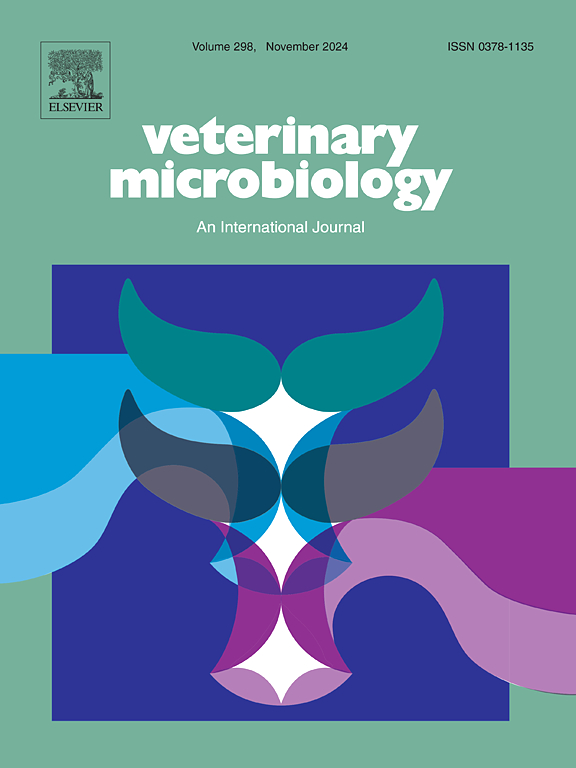CircLSM14A通过miR-27b-5p/HMGB1轴调控PEDV复制。
IF 2.7
2区 农林科学
Q3 MICROBIOLOGY
引用次数: 0
摘要
环状rna (circRNAs)在各种生理和病理过程中发挥着至关重要的作用,包括病毒与宿主之间复杂的相互作用。然而,猪乳外泌体衍生环状rna影响猪流行性腹泻病毒(PEDV)复制的调控机制尚不清楚。基于我们之前对猪乳外泌体中非编码rna的测序分析,我们确定了可能调节PEDV在仔猪肠道中复制的环状rna分子,并在细胞和仔猪肠道类器官水平上验证了这些发现。结果表明,circLSM14A存在于猪乳外泌体中,作为内源性miR-27b-5p海绵,并隔离和抑制miR-27b-5p活性。这种抑制增加了高迁移率组蛋白1 (HMGB1)的表达,进而促进下游信号分子TLR4、NF-κB1、NF-κB2、Rel和Beclin1的表达,最终增强了PEDV在细胞和肠道类器官水平上的复制。本研究确定circLSM14A是参与猪乳外泌体PEDV复制的调控因子之一。这些发现促进了我们对circLSM14A生物学功能的理解,并阐明了乳外泌体携带的非编码rna在调节PEDV复制中的作用。本研究为PEDV的防治提供了新的思路和途径。本文章由计算机程序翻译,如有差异,请以英文原文为准。
CircLSM14A regulates PEDV replication via the miR-27b-5p/HMGB1 axis
Circular RNAs (circRNAs) play crucial roles in various physiological and pathological processes, including the complex interactions between viruses and hosts. However, the regulatory mechanism by which porcine milk exosome-derived circRNAs affect porcine epidemic diarrhea virus (PEDV) replication remains poorly understood. Building on our previous sequencing analysis of non-coding RNAs in porcine milk exosomes, we identified circRNA molecules that may regulate PEDV replication in the intestines of piglets and validated these findings at both the cellular and piglet intestinal organoid levels. The results demonstrated that circLSM14A was present in porcine milk exosomes, acted as an endogenous miR-27b-5p sponge, and sequestered and inhibited miR-27b-5p activity. This inhibition increased the expression of high mobility group protein 1 (HMGB1), which subsequently promoted the expression of downstream signaling molecules, including TLR4, NF-κB1, NF-κB2, Rel, and Beclin1, and ultimately enhanced PEDV replication at cellular and intestinal organoid levels. This study identifies circLSM14A as one of the regulators involved in PEDV replication in porcine milk exosomes. These findings advance our understanding of the biological functions of circLSM14A and clarify the role of non-coding RNAs carried by milk exosomes in regulating PEDV replication. This research provides new insights and approaches for the prevention and control of PEDV.
求助全文
通过发布文献求助,成功后即可免费获取论文全文。
去求助
来源期刊

Veterinary microbiology
农林科学-兽医学
CiteScore
5.90
自引率
6.10%
发文量
221
审稿时长
52 days
期刊介绍:
Veterinary Microbiology is concerned with microbial (bacterial, fungal, viral) diseases of domesticated vertebrate animals (livestock, companion animals, fur-bearing animals, game, poultry, fish) that supply food, other useful products or companionship. In addition, Microbial diseases of wild animals living in captivity, or as members of the feral fauna will also be considered if the infections are of interest because of their interrelation with humans (zoonoses) and/or domestic animals. Studies of antimicrobial resistance are also included, provided that the results represent a substantial advance in knowledge. Authors are strongly encouraged to read - prior to submission - the Editorials (''Scope or cope'' and ''Scope or cope II'') published previously in the journal. The Editors reserve the right to suggest submission to another journal for those papers which they feel would be more appropriate for consideration by that journal.
Original research papers of high quality and novelty on aspects of control, host response, molecular biology, pathogenesis, prevention, and treatment of microbial diseases of animals are published. Papers dealing primarily with immunology, epidemiology, molecular biology and antiviral or microbial agents will only be considered if they demonstrate a clear impact on a disease. Papers focusing solely on diagnostic techniques (such as another PCR protocol or ELISA) will not be published - focus should be on a microorganism and not on a particular technique. Papers only reporting microbial sequences, transcriptomics data, or proteomics data will not be considered unless the results represent a substantial advance in knowledge.
Drug trial papers will be considered if they have general application or significance. Papers on the identification of microorganisms will also be considered, but detailed taxonomic studies do not fall within the scope of the journal. Case reports will not be published, unless they have general application or contain novel aspects. Papers of geographically limited interest, which repeat what had been established elsewhere will not be considered. The readership of the journal is global.
 求助内容:
求助内容: 应助结果提醒方式:
应助结果提醒方式:


